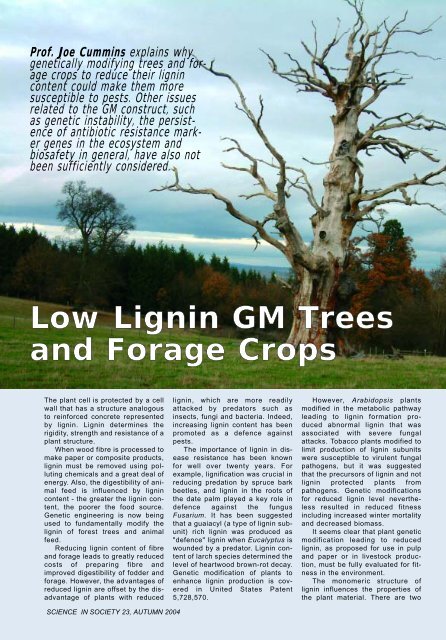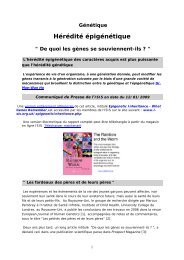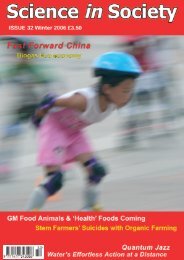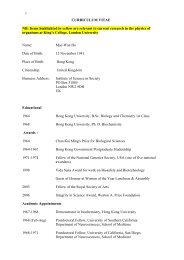Ethiopia goes organic to feed herself - The Institute of Science In ...
Ethiopia goes organic to feed herself - The Institute of Science In ...
Ethiopia goes organic to feed herself - The Institute of Science In ...
Create successful ePaper yourself
Turn your PDF publications into a flip-book with our unique Google optimized e-Paper software.
Pr<strong>of</strong>. Joe Cummins explains why<br />
genetically modifying trees and forage<br />
crops <strong>to</strong> reduce their lignin<br />
content could make them more<br />
susceptible <strong>to</strong> pests. Other issues<br />
related <strong>to</strong> the GM construct, such<br />
as genetic instability, the persistence<br />
<strong>of</strong> antibiotic resistance marker<br />
genes in the ecosystem and<br />
biosafety in general, have also not<br />
been sufficiently considered.<br />
Low Lignin GM Trees<br />
and Forage Crops<br />
<strong>The</strong> plant cell is protected by a cell<br />
wall that has a structure analogous<br />
<strong>to</strong> reinforced concrete represented<br />
by lignin. Lignin determines the<br />
rigidity, strength and resistance <strong>of</strong> a<br />
plant structure.<br />
When wood fibre is processed <strong>to</strong><br />
make paper or composite products,<br />
lignin must be removed using polluting<br />
chemicals and a great deal <strong>of</strong><br />
energy. Also, the digestibility <strong>of</strong> animal<br />
<strong>feed</strong> is influenced by lignin<br />
content - the greater the lignin content,<br />
the poorer the food source.<br />
Genetic engineering is now being<br />
used <strong>to</strong> fundamentally modify the<br />
lignin <strong>of</strong> forest trees and animal<br />
<strong>feed</strong>.<br />
Reducing lignin content <strong>of</strong> fibre<br />
and forage leads <strong>to</strong> greatly reduced<br />
costs <strong>of</strong> preparing fibre and<br />
improved digestibility <strong>of</strong> fodder and<br />
forage. However, the advantages <strong>of</strong><br />
reduced lignin are <strong>of</strong>fset by the disadvantage<br />
<strong>of</strong> plants with reduced<br />
lignin, which are more readily<br />
attacked by preda<strong>to</strong>rs such as<br />
insects, fungi and bacteria. <strong>In</strong>deed,<br />
increasing lignin content has been<br />
promoted as a defence against<br />
pests.<br />
<strong>The</strong> importance <strong>of</strong> lignin in disease<br />
resistance has been known<br />
for well over twenty years. For<br />
example, lignification was crucial in<br />
reducing predation by spruce bark<br />
beetles, and lignin in the roots <strong>of</strong><br />
the date palm played a key role in<br />
defence against the fungus<br />
Fusarium. It has been suggested<br />
that a guaiacyl (a type <strong>of</strong> lignin subunit)<br />
rich lignin was produced as<br />
"defence" lignin when Eucalyptus is<br />
wounded by a preda<strong>to</strong>r. Lignin content<br />
<strong>of</strong> larch species determined the<br />
level <strong>of</strong> heartwood brown-rot decay.<br />
Genetic modification <strong>of</strong> plants <strong>to</strong><br />
enhance lignin production is covered<br />
in United States Patent<br />
5,728,570.<br />
However, Arabidopsis plants<br />
modified in the metabolic pathway<br />
leading <strong>to</strong> lignin formation produced<br />
abnormal lignin that was<br />
associated with severe fungal<br />
attacks. Tobacco plants modified <strong>to</strong><br />
limit production <strong>of</strong> lignin subunits<br />
were susceptible <strong>to</strong> virulent fungal<br />
pathogens, but it was suggested<br />
that the precursors <strong>of</strong> lignin and not<br />
lignin protected plants from<br />
pathogens. Genetic modifications<br />
for reduced lignin level nevertheless<br />
resulted in reduced fitness<br />
including increased winter mortality<br />
and decreased biomass.<br />
It seems clear that plant genetic<br />
modification leading <strong>to</strong> reduced<br />
lignin, as proposed for use in pulp<br />
and paper or in lives<strong>to</strong>ck production,<br />
must be fully evaluated for fitness<br />
in the environment.<br />
<strong>The</strong> monomeric structure <strong>of</strong><br />
lignin influences the properties <strong>of</strong><br />
the plant material. <strong>The</strong>re are two<br />
SCIENCE IN SOCIETY 23, AUTUMN 2004











